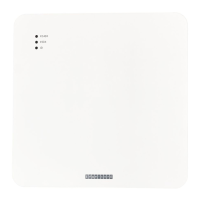Chapter 4
| Wireless Settings
Radio Settings
– 72 –
Acct Server — Specifies the IP address or host name of the
RADIUS accounting server.
Acct Port — The UDP port number used by the RADIUS server for
accounting messages. (Range: 1024-65535; Default: 1813)
Acct Secret — A shared text string used to encrypt messages
between the access point and the RADIUS server. Be sure that the
same text string is specified on the RADIUS accounting server. Do
not use blank spaces in the string. (Maximum length: 200
characters)
Acct Interim Interval — The time (in seconds) between each
accounting update sent to the server. (Range: 60-600 seconds;
Default: 60 se
conds)
WPA2-EAP — WPA was introduced as an interim solution for the
vulnerability of WEP pending the ratification of the IEEE 802.11i wireless
security standard. In effect, the WPA security features are a subset of the
802.11i standard. WPA2 includes the now ratified 802.11i standard, but
also offers backward compatibility with WPA. Therefore, WPA2 includes the
same 802.1X and PSK modes of operation and support for TKIP
encryption.
A RADIUS server is used for authentication, and can also be used to
a
ccounting.
Refer to WPA-PSK for a description of encryption methods.
Refer to WPA-EAP for a information on configuring the RADIUS server.
WPA3 Personal — Clients using WPA3 with Simultaneous Authentication
of Equals (SAE) are accepted for authentication.
WPA3 provides more robust password-based authentication called
Simultaneous Authentication of Equals (SAE), which replaces Pre-Share
Key
(P
SK) in WPA2-Personal. This technology prevents offline dictionary attacks
so that data traffic can be transmitted securely.
WPA3 Personal Transition — Clients using WPA3 with SAE or clients
using WPA2 with PSK are accepted for authentication. The AP negotiates
the supported authentication and encryption with each client before
allowing access to the network.
WPA3 Enterprise — An enhanced version of WPA2-EAP security that uses
more robust encryption. Clients must support one of the stronger WPA3
encryption options and use
Protected Management Frames (PMF) to be
able to access the network. The use of IEEE 802.1X network access control
and a RADIUS server is required.

